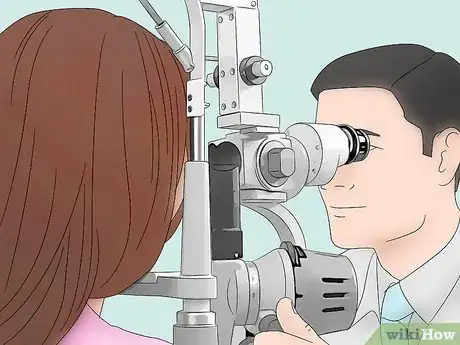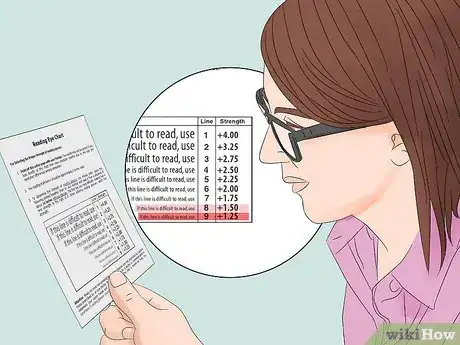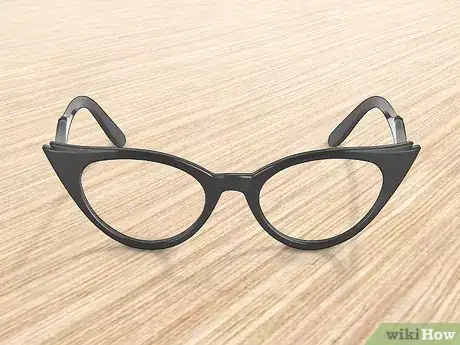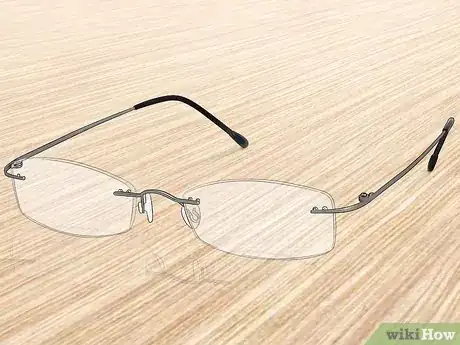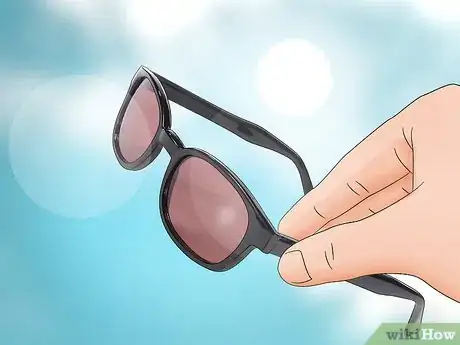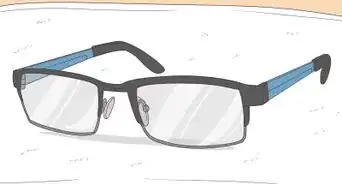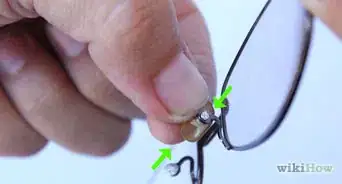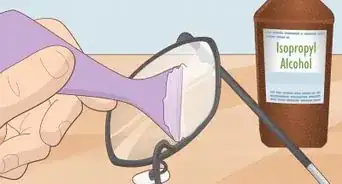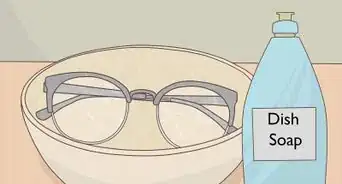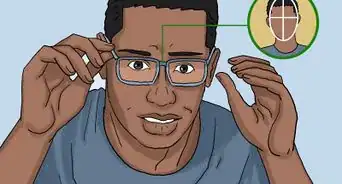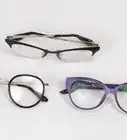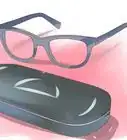This article was co-authored by Mark Cannon, OD and by wikiHow staff writer, Danielle Blinka, MA, MPA. Dr. Mark Cannon is an Optometrist and Chief of Optometry at Cannon Eyecare, a family-owned optometry practice in Seattle, Washington. With over 10 years of experience, Dr. Cannon specializes in ocular disease, dry eye, glaucoma, eye infection, contact lens fitting, and pediatrics. Dr. Cannon holds a BS in Biology and Psychology from Indiana University. He received his Doctorate in Optometry from Indiana University School of Optometry, where he earned the Dean's Scholar award and participated in years of ophthalmic research. Dr. Cannon worked as an optometrist for four years before founding Cannon Eyecare, which offers full-scope medical optometry services. Dr. Cannon is a member of the American Optometric Association, King County Optometric Society, and the Optometric Physicians of Washington.
There are 11 references cited in this article, which can be found at the bottom of the page.
This article has been viewed 20,581 times.
Struggling to read can be frustrating and annoying, but it's a very common experience. If you're having trouble reading small text, you likely need reading glasses. Most people need reading glasses after they turn 40, so you aren't alone! To pick your perfect pair of reading glasses, start by finding the right strength.[1] Then, you can search for a frame that fits your personal style. Additionally, consider buying multiple pairs to meet your specific needs. To help you out, we've put together some tips on how to choose the right reading glasses strength, or power, and find the best frames for your face shape.
Steps
Finding the Right Strength
-
1Visit an eye doctor to find out if you need prescription glasses.[2] Your doctor will conduct a simple, painless exam to determine your prescription. Once you receive your prescription, purchase a pair of reading glasses that's made just for you. As another option, purchase bifocal or progressive lenses so you can see both far away and up close.[3]
- Tell your doctor that you're having trouble reading.
- You might still be able to purchase drugstore reading glasses. Ask your doctor if this is an option for you.
Warning: You need to see your doctor if you can't find reading glasses that work for you, you wear glasses to correct your distance vision, or you have problems like astigmatism.
-
2Check the glasses for a label that shows the lens power. Look for a sticker on the lenses or find the tag on the arm of the glasses. Find the number with a “+” sign in front of it. This is the power of the lens, which is the prescription strength. You'll use this number to pick your reading glasses.[4]
- Most brands of reading glasses range in power from +1.00 to +4.00. They'll increase in +.25 increments, such as +1.00, +1.25, +1.50, +1.75, +2.00, etc.
Advertisement -
3Test out the reading glasses for a simple way to choose. Try the lowest power fist, which will typically be +1.00 or +1.25, depending on the brand. Put the glasses on, then hold your reading material at a comfortable distance. Check if you can read the words clearly.[5]
- If the words are still blurry or small, go up to the next power. For instance, try a pair of +1.50 glasses.
Tip: Some reading glasses displays will have a reading chart that helps you test the readers. As an alternative, use a book or magazine to make sure the glasses work for you.
-
4Use a reading chart to accurately determine the strength you need. Do an online search for a reading chart designed to help you pick reading glasses. For best results, print out the chart so it's the correct size. Hold the chart at a comfortable distance, like you're reading a book. Then, find the smallest line you can read, which will tell you which power to buy.[6]
- For instance, if you can read the smallest line, it may recommend you get a pair that's +1.25.
- It's best to print out the chart because your phone or computer screen may enlarge or shrink it, which will alter your results.
-
5Choose the lowest power that allows you to read comfortably. Over time, your vision will naturally worsen, which means you'll need a stronger power of reading glasses. However, picking a stronger power than you need right now may make your vision worsen faster. Always use the weakest pair of reading glasses that work for you.[7]
- For instance, if you can read with both +1.75 and +2.00 glasses, pick the +1.75 pair.
- Don't pick a lower power if you feel like you're still straining to read or you can't hold your reading material at a comfortable distance. You don't want to strain your eyes.
Selecting Flattering Frames
-
1Pick a cat-eye frame if you like a retro look. Cat-eye frames are a classic, feminine look that enhance your cheekbones. Try on different cat-eye styles to find one that works for you. You can even find frames with prints and embellishments, like gemstones.[8]
- Pick a modern cat-eye design to avoid a look that ages you. For instance, pick a bold color or print, such as leopard print.
-
2Choose a rectangular frame for an oval, heart-shaped, or round face. Narrow rectangular frames can compliment rounder face shapes. They can balance out an oval face, lengthen a round face, and hide the width of a heart-shaped face. Try on several rectangular frames to find the one that looks best on you.[9]
- You can find both plastic and metal rectangular frames.
-
3Pick a thin oval frame if you have a square jawline. Small oval-shaped lenses can soften a square or angular jawline. Try on different colors and widths to find one that looks great on you. You might also try different colors and styles, like tortoise shell.[10]
- These frames may come in metal or plastic.
-
4Look for a wireless frame to minimize the look of your glasses. Wireless frames are held together with thin metal or nylon pieces. They are typically less noticeable than other frames because they blend into your face. Try on rimless styles so you can see if you like them.[11]
- You can find round, oval, or rectangular lenses with wireless frames.
- Keep in mind that wireless frames aren't as durable and may break easily.
Variation: You can also try a semi-rimless design that has a frame on the top but not the bottom. It can minimize the look of glasses while still giving your glasses some durability.
-
5Make sure the frames feel comfortable on your nose and temples. Check that your reading glasses don't pinch the bridge of your nose or slide down it. Then, notice how they feel on your temples and above your ears. They should rest comfortably against your skin but shouldn't feel too tight.[12]
- If your reading glasses are sliding down, you might be able to get them adjusted at an eyewear store. Some stores will adjust your glasses even if you didn't buy them there.
Picking Readers to Meet Your Needs
-
1Choose a larger frame if you've never worn glasses. It'll likely take some time for you to get used to wearing glasses, and wearing bigger frames may help. This trains your eye to look through the center of the lens, which is where the power will be. Pick a frame with larger lenses that fits your face comfortably.[13]
- Once you get used to wearing glasses, you can try smaller frames.
-
2Opt for half-eye frames if you want to wear them all the time. Half-eye frames are designed to be worn low on your nose. They allow you to see far away by looking over your glasses while still being able to look down through the glasses to read.[14] Look for half-eye frames that fit comfortably on your nose. Before you buy them, test them out to make sure you can easily see over them.
- You might prefer this type of reading glasses if you switch between looking at a distance and reading often.
-
3Get a pair of sun readers if you like to read outdoors. Sun readers are tinted reading glasses, so they block out some of the sun's rays. Consider getting a pair if you like to read outside. They'll help you read easily without harming your eyes.
- You can find sun readers at an eyewear shop or online.
- If you're getting prescription reading glasses, ask your optician about sun readers.
-
4Buy a pair of computer readers if you struggle to read your screen. You may notice that it's hard to see your computer. To find a pair of computer readers, start with reading glasses that are half the power of your normal reading glasses. Then, hold your reading material about 20 to 26 in (51 to 66 cm) in front of your face to see if you can read. If you can't read it, go up in power until you find a pair that works for you.[15]
- You can use regular reading glasses as computer readers, but you'll need to get separate pairs for reading and seeing the computer. Your readers will be stronger than your computer glasses.
- In most cases, your computer glasses will be about 60% of the power of your reading glasses. For instance, if you use +2.00 glasses to read, you'll probably need +1.25 computer glasses.
- If you can't find a pair that works for you, get an eye exam from your eye doctor to get a prescription for computer glasses.
Warnings
- Don't buy reading glasses if you're having trouble seeing far away. They only help you see up close, so they may make your vision worse. Instead, visit your eye doctor to get an eye exam.⧼thumbs_response⧽
References
- ↑ https://health.clevelandclinic.org/reading-glasses-how-to-find-the-perfect-pair-at-your-drugstore/
- ↑ Mark Cannon, OD. Board Certified Optometrist. Expert Interview. 24 August 2020.
- ↑ https://health.clevelandclinic.org/reading-glasses-how-to-find-the-perfect-pair-at-your-drugstore/
- ↑ https://health.clevelandclinic.org/reading-glasses-how-to-find-the-perfect-pair-at-your-drugstore/
- ↑ https://www.aclens.com/global/lensimages/pdf/reading-strength.pdf
- ↑ https://www.allaboutvision.com/eye-test/free-eye-chart/
- ↑ https://www.allaboutvision.com/eyeglasses/faq/reading-glasses-power.htm
- ↑ https://www.allaboutvision.com/eyeglasses/accessorize.htm
- ↑ https://www.allaboutvision.com/eyeglasses/eyeglasses_shape_color_analysis.htm
- ↑ https://www.allaboutvision.com/eyeglasses/eyeglasses_shape_color_analysis.htm
- ↑ https://www.aao.org/eye-health/glasses-contacts/eyeglass-frame-materials
- ↑ https://www.aao.org/eye-health/glasses-contacts/tips-choosing-right-reading-glasses
- ↑ https://health.clevelandclinic.org/reading-glasses-how-to-find-the-perfect-pair-at-your-drugstore/
- ↑ https://www.allaboutvision.com/en-ca/reading-glasses/
- ↑ https://www.allaboutvision.com/cvs/computer_glasses.htm
- ↑ https://health.clevelandclinic.org/reading-glasses-how-to-find-the-perfect-pair-at-your-drugstore/
